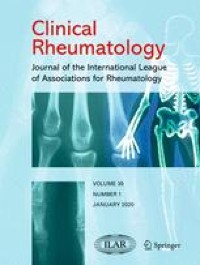|
Αρχειοθήκη ιστολογίου
-
►
2023
(256)
- ► Φεβρουαρίου (140)
- ► Ιανουαρίου (116)
-
►
2022
(1695)
- ► Δεκεμβρίου (78)
- ► Σεπτεμβρίου (142)
- ► Φεβρουαρίου (155)
-
▼
2021
(5507)
- ► Δεκεμβρίου (139)
- ► Σεπτεμβρίου (333)
- ► Φεβρουαρίου (628)
-
▼
Ιανουαρίου
(580)
-
▼
Ιαν 10
(33)
- Sprouty2 Inhibits Migration and Invasion of Fibrob...
- Zingerone Mitigates Carrageenan-Induced Inflammati...
- The Combinatorial Effect of Acetate and Propionate...
- Comorbidities in psoriatic arthritis
- Dose Reduction of Tumor Necrosis Factor Inhibitor ...
- Antiphospholipid Antibodies in Inflammatory and Au...
- Dexamethasone can attenuate the pulmonary inflamma...
- Inflammatory M1-like macrophages polarized by NK-4...
- MicroRNA-520c-3p suppresses vascular endothelium d...
- Comorbidities in psoriatic arthritis
- Antiarrhythmic Treatment Duration and Tachycardia ...
- Surgical Timing and Outcomes of Unilateral Versus ...
- Systemic Artery Vasoconstrictor Therapy in Fontan ...
- On-Air Slips of the Tongue: A Psycholinguistic-Aco...
- Characteristics and outcomes of overlap myositis
- Lung surgery in children and their post-operative ...
- Optimal Rex shunt procedures as a treatment for pe...
- Usefulness of laparoscopic surgery and preoperativ...
- Serrated precancerous colorectal lesions
- Increased perioperative mortality for femoral neck...
- The safety of early versus late ileostomy reversal...
- Experimental evaluation of the fineness of needle ...
- In vitro antileishmanial potentialities of essenti...
- Attenuation of the Induction of TLRs 2 and 4 Mitig...
- Impact of elevated core temperature on cognition i...
- Hypoxic re-exposure retains hematological but not ...
- Comparative Efficacy of Oral Calcitonin-Gene–Relat...
- An Oral-mucosa-on-a-chip sensitively evaluates cel...
- Comparison of universal screening in major lynch-a...
- ACE-2-interacting Domain of SARS-CoV-2 (AIDS) Pept...
- Prevalence and predictors of small intestinal bact...
- The association of the progression of knee osteoar...
- Standardized framework to report on the role of sl...
-
▼
Ιαν 10
(33)
-
►
2020
(1810)
- ► Δεκεμβρίου (544)
- ► Σεπτεμβρίου (32)
- ► Φεβρουαρίου (28)
-
►
2019
(7684)
- ► Δεκεμβρίου (18)
- ► Σεπτεμβρίου (53)
- ► Φεβρουαρίου (2841)
- ► Ιανουαρίου (2803)
-
►
2018
(31838)
- ► Δεκεμβρίου (2810)
- ► Σεπτεμβρίου (2870)
- ► Φεβρουαρίου (2420)
- ► Ιανουαρίου (2395)
-
►
2017
(31987)
- ► Δεκεμβρίου (2460)
- ► Σεπτεμβρίου (2605)
- ► Φεβρουαρίου (2785)
- ► Ιανουαρίου (2830)
-
►
2016
(5308)
- ► Δεκεμβρίου (2118)
- ► Σεπτεμβρίου (877)
- ► Φεβρουαρίου (41)
- ► Ιανουαρίου (39)
Αλέξανδρος Γ. Σφακιανάκης
ΩτοΡινοΛαρυγγολόγος
Αναπαύσεως 5
Άγιος Νικόλαος Κρήτη 72100
2841026182
6032607174
Κυριακή 10 Ιανουαρίου 2021
Prevalence and predictors of small intestinal bacterial overgrowth in systemic sclerosis: a systematic review and meta-analysis
Εγγραφή σε:
Σχόλια ανάρτησης (Atom)



Δεν υπάρχουν σχόλια:
Δημοσίευση σχολίου